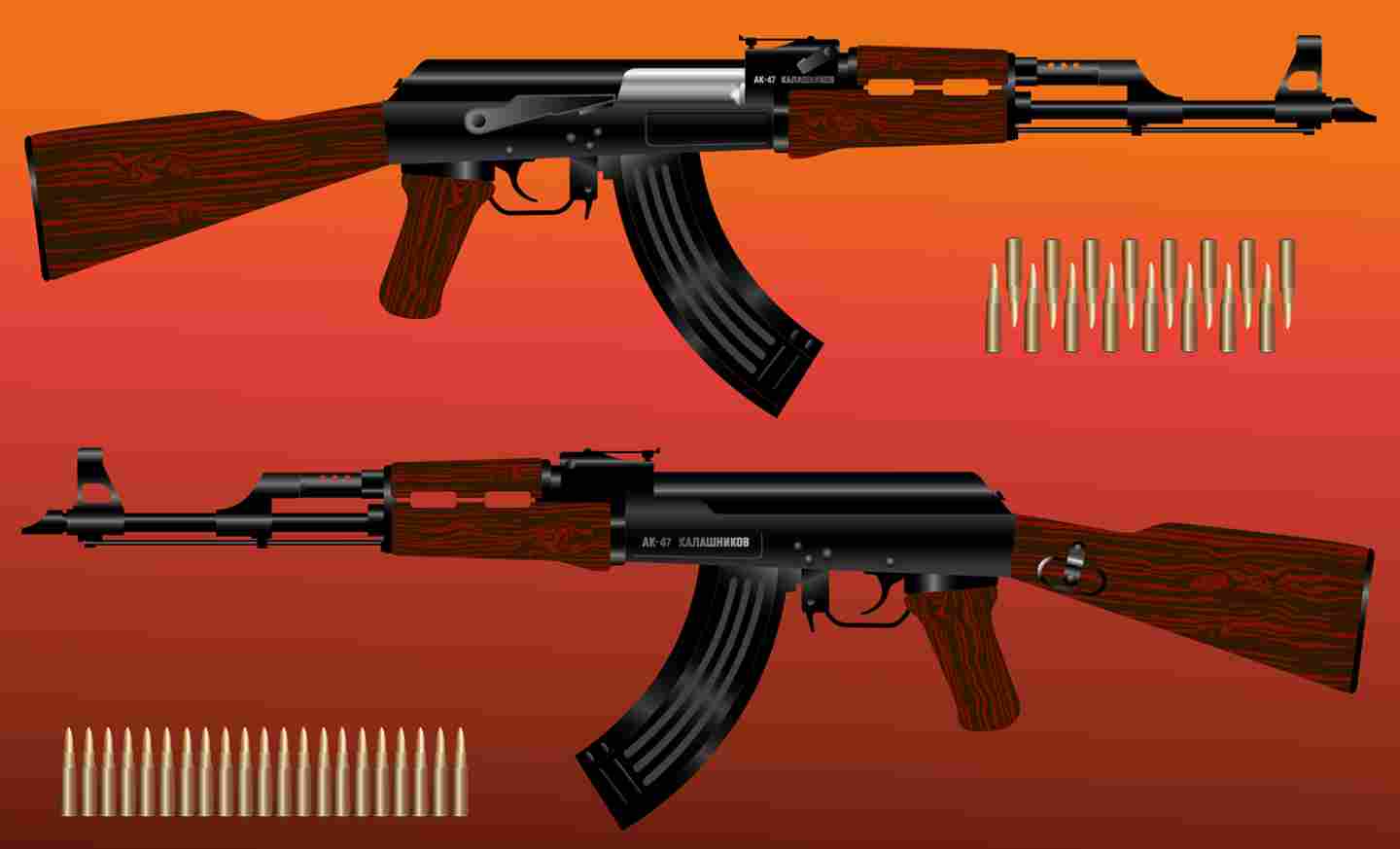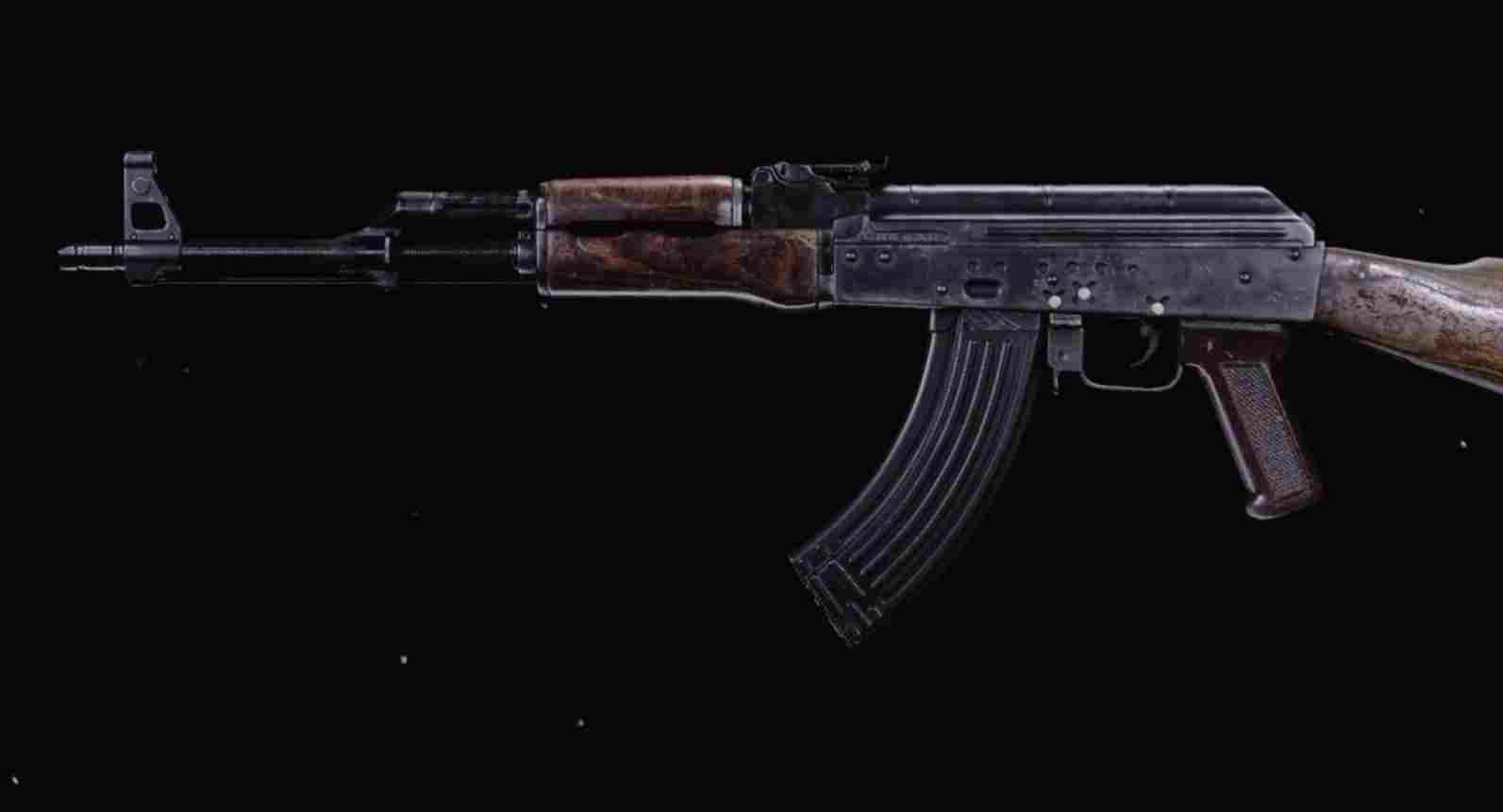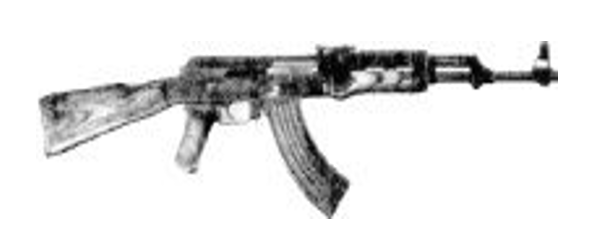
Introduction
The AK-47, officially known as the Avtomat Kalashnikov also known as the Kalashnikov or just AK), is a gas-operated assault rifle that is chambered for the 7.62×39mm cartridge. Developed in the Soviet Union by Russian small-arms designer Mikhail Kalashnikov, it is the originating firearm of the Kalashnikov (or “AK”) family of rifles. After more than seven decades, the AK-47 model and its variants remain the most popular and widely used rifles globally.
The number “47” refers to the year the rifle was finished. Design work on the AK-47 began in 1945. It was presented for official military trials in 1947, and, in 1948, the fixed-stock version was introduced into active service for selected units of the Soviet Army. In early 1949, the AK was officially accepted by the Soviet Armed Forces and used by the majority of the member states of the Warsaw Pact.
Kalashnikov1 assault rifles are the most widespread military weapons in the world. It is estimated that there are between 50 and 70 million of them spread across the world’s five continents. They are used daily by soldiers, fighters, and gang members to inflict untold suffering in many countries. The spread of these weapons continues unchecked mainly by governments, threatening the lives and safety of millions as weapons fall into irresponsible hands. More than ever, the Kalashnikov rifle is the weapon of choice for many armies, militias, armed gangs, law enforcement officials, rebels, and other private actors who abuse fundamental human rights and operate beyond the international humanitarian law parameters laid down by the Geneva Conventions and other relevant international law.
Although the United Nations and its member states have taken concrete action to limit the proliferation of nuclear, biological, and chemical weapons of mass destruction through international treaties and monitoring organizations, the number one tool used for killing and injuring civilians today is small arms, including the assault rifle, which is reaching more countries than ever before. On 26 June 2006, the UN Review Conference on the Illicit Trade in Small Arms and Light Weapons began in New York.
At this conference, governments have an opportunity to agree on effective and comprehensive controls to prevent the proliferation and misuse of small arms and light weapons, including assault rifles like the AK-47. In October 2006, at the UN General Assembly, governments should agree to negotiate a new global Arms Trade Treaty (ATT) to regulate international transfers of all conventional arms, including military assault rifles.
The proliferation of Kalashnikovs has resulted in such deadly weapons being used to massacre, maim, rape and abuse, torture, and fuel violent crime in countries as diverse as Afghanistan, Britain, the Democratic Republic of Congo (DRC), Iraq, Mexico, Sierra Leone, the USA, Venezuela, and Yemen. With no global treaty to regulate the sale of such weapons and no international organization to effectively monitor transfers of small arms and light weapons, Kalashnikov assault rifles are a truly global commodity now traded, warehoused, and produced in more countries than at any time in their sixty-year history.
History
The name AK-47 is derived from the Russian words “Avtomat Kalashnikova”, in honor of its automatic firing capabilities and its principal designer, Mikhail Kalashnikov. The 47 denotes the year 1947 when the trials started on the version of the rifle that was finally approved for adoption by the Soviet armed forces soon after.
By any measure, the AK-47 is the most successful assault rifle in human history. In terms of the number of guns produced, duration of service, and worldwide deployment, it has no equal.
The genius of the rifle is not that it was original. It is actually an amalgamation of several pre-existing design concepts. The trigger mechanism, safety catch, rotating bolt, and gas-driven action borrowed heavily from other firearms. But these features were combined with a platform that offered legendary durability and low manufacturing costs.
The result was a lightweight rifle with moderate recoil that was easy to wield and that still placed tremendous firepower into the hands of individual soldiers. Accuracy was a secondary consideration. The fact that it gave soldiers the ability to deliver massed fire in an effective fashion was what made it unlike any other rifle before and, some would still argue, ever since.
Mikhail Timofeyevich Kalashnikov was born in 1919 to peasants and went on to become a lieutenant-general in the Soviet Army, a Hero of the State, and one of the most famous firearms designers in history.
A self-taught tinkerer, Kalashnikov was conscripted into the Red Army in 1938 and because of his small stature and mechanical aptitude was made a tank mechanic. During World War II, he became a tank commander and was seriously wounded in combat. During his recuperation from late 1941 to 1942, he worked on a design for a new rifle for the Soviet military. That design was never adopted, but his ingenuity caught the eye of his superiors, who then reassigned him to a small-arms design group.
The actual birth is marked by the meeting of the People’s Commissariat for Arms on June 15, 1943. On this occasion, an automatic rifle, captured of German origin, was presented, which caused a real cataclysm in the Soviet military and political circles. The German weapon that helped inspire the creation of the AK (Avtomat Kalashnikova) was the Sturmgewehr 44 (Assault Rifle 1944) also known as the MP43 and MP44. Many historians claim that just like the AK-47, the STG-44 was ahead of its time because of the accuracy and power round the gun was shooting.
What Mikhail has taken and improved from the STG-44 was the firing mechanism which allowed for a good fire rate whilst maintaining a controllable recoil, however, the problem that the STG-44 presented sometimes was the failure to eject the empty cartridge after firing. This problem mostly occurred after a long period of constant firing.
It was there that he, along with other engineers, developed the iconic AK-47. He continued to develop, expand, and improve the AK family of rifles throughout his later career. All told, he helped create about 150 different firearms designs.
He died in 2013 at the age of 94 in a Russian hospital after a prolonged illness.
The AK-47 Time Line
1943: The Soviet Union develops the 7.62x39mm cartridge.
1945: A contest is launched in secret by the USSR to develop a new model assault rifle.
1947: Mikhail Kalashnikov and his team of designers create the AK-47, which is submitted for trials and accepted as the winning entry.
1949: The AK-47 is officially adopted by the Soviet Union.
1956: China creates its own AK-47 clone, known as the Type 56.
1959: The AKM is introduced. Its stamped metal (versus milled) receiver is much less costly to produce and allows for more widespread production.
1974: AK-74 is introduced in the lighter recoiling 5.45x39mm cartridge.
Features Of AK-47 Gun

Loading:-
Check ammo for dents in cartridges and bad primers.
When inserting a magazine into the magazine well, be sure to insert the forward lip of the magazine into the well first. Be sure that the magazine is fully seated.
Firing
Pull charging handles, fully to the rear, and release.
Note: Do Not Ride Charging Handle Forward:
when on the firing line, keep your weapon up and pointed downrange at all times. If you have a malfunction, raise your hand and range personnel will aid you.
Caution: Only blank ammunition may be fired when the blank firing device is in place. Do not use the cap or the combination tool kit as a blank firing device.
Hand Grenade Launcher: The hand grenade launcher is installed by removing the muzzle nut and screwing the launcher onto the weapon.
To Fire The Grenade: Insert a grenade with the pin pulled into the launcher.
Caution: A special type cartridge is used for firing the grenade. Place the butt of the weapon on the ground and fire from this position. The maximum effective range the grenade can be fired is 250 meters.
The Bayonet: It is affixed by positioning its loops in front of the muzzle nut and gas cylinder body and sliding the bayonet to the rear until the bayonet catch engages the muzzle nut. The bayonet is removed by pulling the catch located behind the hilt, away from the handle, and sliding the bayonet forward and off.
Plastic Magazine: The Soviet AK-47 metal magazine is gradually being replaced by the plastic magazine, which is lighter than the metal. The plastic magazine, because it is lightweight and waterproof, is used mainly by marines, airborne, and armor units.


The AK-47 is a short, compact, selective-fired weapon designed by the Soviets in 1946 which fires a cartridge intermediate in power between submachine gun and rifle cartridges. It has mild recoil which gives it the capability of delivering effective full-automatic fire up to 300 meters.
In addition to the Soviet Union, the People’s Republic of China, East Germany, Poland, Bulgaria, Romania, North Korea, Hungary, and Yugoslavia have manufactured the AK-47. The selector markings on the right side of the receiver provide a ready means of identifying the country of origin.
The AK-47 is produced in two different basic models – one with a conventional fixed wooden stock and the other with a folding metal stock (fig 6). The folding stock is used mostly by airborne and armor units.
Technical Data
Cartridge | 7.62x39mm |
Feed | Magazine (fig 7) |
Magazine capacity | 30 rds |
Gas operated |
|
Weight | 9.5 lb |
Length | 34.2 in |
Length w/folded stock | 27.5 in |
Rate of fire semiautomatic | 40 rpm |
Rate of fire automatic | 100 rpm |
Rate of fire cyclic | 600-800 rpm |
Maximum effective range | 400 meters |
Operation
Loading the Magazine: Place around between the feed lips. Press it down until it locks inside the magazine. Repeat until the magazine is full (30 rds).
Inserting the magazine into the receiver: Can’t the magazine forward so the lug on the front of the magazine engages with its recess in the magazine well; then pull the magazine to the rear until it snaps into place.
Loading the AK-47: Pull the operating handle, fully to the rear and release it so the lug on the bottom of the bolt can strip a round from the magazine and into the chamber.
Caution: Always keep the selector in the safe (upper) position until the weapon is ready to be fired.
Firing the AK-47: Place the selector in the desired position (automatic middle position, and semi-automatic lower position). Aim using a normal sight picture and pull the trigger.
The AK-47 with the metal stock can also be fired with the stock folded. This is done by pressing the stock latch located on the left rear of the receiver and swinging the stock down beneath the weapon. This position is used mainly by airborne and armor units.
Immediate action: For a runaway gun, keep the rifle pointed up and downrange until all ammunition is expended. Clear the weapon and inspect it to determine the cause of the malfunction. Immediate action for a misfire is to keep the rifle pointed down range for at least one minute. Then pull the operating handle to the rear and eject the misfired round. Load a new round and attempt to fire it. If it does not fire, wait one minute and then unload the rifle. Inspect to determine the cause of the malfunction.
Unloading: Remove the magazine by pressing the magazine catch toward the magazine; then swing the magazine forward and out of the receiver. Pull the operating handle fully to the rear, and inspect the chamber and receiver. If no cartridge is present, release the operating handle and pull the trigger.
Zeroing: Set the rear sight for the desired range by pressing in on the slide catch and moving the slide bar along with the leaf until the front edge of the bar is aligned with the line below the number that corresponds with the range in meters.
The front sight post can be screwed in or out of its base to adjust for elevation. The wrench in the combination tool kit is used for this purpose. Lateral zeroing is done by moving the cylindrical front sight post mount from side to side using the lateral zeroing tool.
If the strike of the bullet is below the control point, the front sight should be screwed in. If above, it should be screwed out. If the strike of the bullet is to the left of the control point, the slide of the front sight should be moved to the left; if to the right, to the right.
Moving the front sight slide to the left, right, up, or down 1mm, changes the strike of the bullet by 26cm at 100 meters. One full turn on the front sight post moves the strike of the bullet 20cm when firing at 100 meters. Front sight post changes should be verified by a group of four individually aimed shots. After the weapon has been zeroed, the old mark should be removed and a new one written in.
Disassembly
Unloading and clearing the AK-47: Remove the magazine and pull the operating handle fully to the rear. Inspect the chamber and receiver to ensure no cartridges are present. Release the operating handle and pull the trigger.
Remove the bolt cover: Press the serrated end of the driving spring guide into the bolt cover, and while holding the guide in, lift off the bolt cover, rear-end first.
Remove the driving spring assembly: Push forward on the end of the driving spring guide, disengaging it from its seat in the rear of the receiver; then pull the complete driving spring assembly out of the bolt carrier.
Remove bolt and carrier: Pull the operating handle fully to the rear, lift the bolt carrier slightly upward and then remove the bolt and carrier by pulling it to the rear.
Remove the bolt from the carrier: Press the bolt into the carrier until the bolt operating lug can be twisted free of its cam path in the carrier. Pull the bolt straight forward and out of the carrier.
Remove gas cylinder tube: Rotate the gas cylinder tube lock upward to free the gas cylinder tube. Pull up on the rear of the handguard and remove the tube.
Accessories
- The following accessories will be issued when available with the AK-47:
- Combination Tool Kit
- Bayonet
- Sling
- Blank Firing Device
- Night Sighting Device
Night Sighting Device: The night sighting device is attached by snapping it over the sight. It can be moved out of the way in order to use conventional sights in the daytime. To use this device, align the luminous dots over each other and on the target, aim, and fire.
Blank firing device: The blank firing device is installed by pressing in the muzzle nut locking plunger, unscrewing the muzzle nut by turning it clockwise, and replacing it. It is removed the same way as the muzzle nut.
Caution: Only blank ammunition may be fired when the blank firing device is in place. Do not use the cap of the combination tool kit as a blank firing device.
Hand grenade launcher: The hand grenade launcher is installed by removing the muzzle nut and screwing the launcher onto the weapon
To fire the grenade, insert a grenade with the pin pulled into the launcher.
Caution: A special type cartridge is used for firing the grenade. Place the butt of the weapon on the ground and fire from this position. The maximum effective range the grenade can be fired is 150 meters.
Plastic magazine: The Soviet AK-47 metal magazine is gradually being replaced by the plastic magazine which is lighter than the metal. The plastic magazine, because it is lightweight and waterproof, is used mainly by marines, airborne, and armor units.
Maintenance
- Care and cleaning: The AK-47 rifle must be kept in proper working order and be ready for action. This is achieved by timely and capable cleaning and lubricating.
=> The AK-47 assault rifle should be cleaned:
During preparation for firing.
After firing with the ball and blank cartridges. The receiver, bore, chamber, gas piston, slide, and bolt are cleaned and lubricated immediately after firing. Final cleaning takes place daily over the next three or four days.
During any combat situation and in extended exercise; daily during noncombat action periods.
No less than once a week if the rifle is not used. Oil should be placed only on well-cleaned and dry metal surfaces immediately after cleaning so that moisture is not allowed to form on the metal.
Service And Training Ammunition
- The AK-47 automatic rifle fires the 7.62x39mm round, M1943. The rounds have varying construction depending upon their purpose. The weight of the bullets and their muzzle velocity is selected so that firing with the different bullets can be conducted with the same sight settings. Ammunition is divided into service and auxiliary types.
1. Service Ammunition And Its Use
Service ammunition is divided into ball cartridges and special-purpose cartridges.
Ball ammunition is used to engage enemy personnel.
Special ammunition, depending upon its construction, is designed for target indication and correction of fire, igniting the fuel and highly inflammable objects and destroying lightly armored targets.
Tracer cartridges are designed for target indication, fire adjustment, signal purposes, and engaging personnel. Tracer bullets can ignite straw roofs, dry grass, etc. The path of the bullet is indicated by a red flame. The flame can be seen from a distance of 700 meters.
AP-incendiary cartridges are used to destroy fuel (kerosene, gasoline) and for destroying targets protected by thin armor plating at ranges up to 300 meters.
Incendiary cartridges are used to destroy fuel in iron tanks up to 3 millimeters thick. Incendiary cartridges also contain a tracer element. The path of the bullet is indicated by a red flame which can be seen day or night. It can be seen for a distance up to 700 meters.
2. Training Ammunition, Purpose And Construction
Training ammunition includes drilled and blank 7.62mm rounds, M1943.
Drilled rounds are designed for training in loading and firing. On the body or the cartridge case, there are longitudinal grooves, and on the cartridge case mouth, there are marks from the clamping device. The primer is pierced. There is no propellant in the cartridge case.
Blank cartridges are designed for simulating fire and are used in tactical exercises. There is no bullet in the blank cartridges. The mouth is sealed by a star (rosette) crimp. It is dangerous to stand closer than 10 meters away from the muzzle face when blank cartridges are being fired.
Future Of AK 47 Guns
The future of the Kalashnikov With the production of new variants, including the new Russian AK-100 series, the demand for Kalashnikov rifles is likely to remain strong in the future, with many producers also now offering the weapon in NATO caliber for export markets. Evidence suggests that the Kalashnikov 7.62 x 39 mm caliber assault rifle will remain the dominant military assault rifle in many parts of the world at least for the next two decades and probably longer. Venezuela has recently signed production contracts for large numbers of Kalashnikov weapons. In June 2005, Jane’s Defence reported that Venezuela had ordered 100,000 Kalashnikov AK-103 assault rifles in a US$54 million deal.
The deal also involved the assembly of the weapons in Venezuela, adding another production center for the Kalashnikov, its first in the Americas.33 In June 2006 it was reported that an initial batch of some 30,000 weapons had been delivered. The deal has caused controversy in the USA, as the US government believes that weapons produced in Venezuela may end up in the hands of Colombian rebels.34 Kalashnikovs have been supplied to Colombian rebels before from within the region; in 1999, under a deal involving corrupt officials in Peru, more than 10,000 AK-47 derivatives brokered from Jordan were diverted to FARC (Revolutionary Armed Forces of Colombia) guerrillas in Colombia, who are documented as serious human rights abuses.
The production of the world’s assault rifles has not been effectively controlled, especially the two most prolific and widely misused assault rifles, the AK-47 and its variants and the G3. For both these weapons, there has been widespread international production through largely uncontrolled licensed production agreements and, in the case of the AK-47, also through unlicensed production.
The proliferation of such production capacity was allowed originally by the Russian and German governments, where the technology began and such rifles were made but have become the responsibility of more and more governments. In the case of many producers of AK variants and derivatives, often there is no production agreement at all36. Often, new production capacity has resulted in surplus stocks of older assault rifles, and such stocks become the source of new cheap and poorly regulated supplies onto the increasingly global market.
Evidence strongly suggests that more effective international regulation of unlicensed arms production and of licensed arms production agreements needs to be a priority, as 8 The AK-47, Control Arms Campaign, June 2006 well as tough and effective international, regional, and national controls over transfers of such weapons themselves, based on states’ existing obligations under relevant international law. Such measures are fundamental to help prevent these deadly assault rifles from falling into the wrong hands.
Conclusion
- The proliferation of, and ease of access to AK-47 and similar assault rifles around the world, more than any other small arm or light weapon, continues to result in mass suffering, with no end in sight. Military assault rifles are intended to be battlefield weapons; they are not designed to be used as normal instruments of law enforcement, nor are they weapons that should be allowed to end up in civilian hands. The danger of unlawful killing and injuries is clearly increased when gangs are wielding automatic and semi-automatic military specification firearms which can fire many rounds in rapid succession. The bullets fired from many types of assault weapons are designed to pass through humans and also through structures, and therefore pose a heightened risk of hitting passers-by. All states must therefore act with due diligence to restrict access to assault rifles and ensure the highest possible standards in the management, transfer, and use of such weapons.
Top 13 Interesting Facts AK-47
The AK-47 was invented in 1946, a year after World War II ended, and entered Soviet Army service in 1949.
The world’s most notorious assault rifle was invented by Lieutenant-General Mikhail Kalashnikov’.
Full form of ‘AK’ is Avtomat Kalashnikova (Automatic Kalashnikov).
Modern AK-47s can mount grenade launchers!
The most effective range of an AK-47 is 400 meters, and it is pretty accurate up to this distance.
AK-47 is so cheap that it is costlier to repair than replace it.
There are over 100 million AK-47s in use in the world today. (And that is just the legal figure).
AK-47 is the world’s most illegally sold assault rifle.
The service life of an AK-47 is between 6000 to 15000 rounds.
AK-47 is a gas-operated, selective-fire assault rifle. (Selective fire means that a shooter can switch from single-fire mode to automatic mode with the click of a trigger.)
It is the only assault rifle in the world that can function in any environment.
Each year, some 250,000 people die from wounds inflicted by an AK-47.
It is one of the most used guns in the world.

For deep details, you can read the full article. Click the link below :






